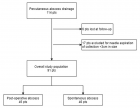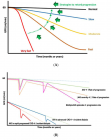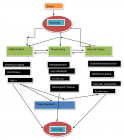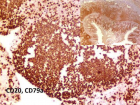Abstract
Review Article
Critical Management of Status Epilepticus
Farahnaz Fallahian* and Seyed MohammadReza Hashemian*
Published: 14 March, 2017 | Volume 2 - Issue 1 | Pages: 001-015
Seizure is clinical manifestation of sudden disruption of the normal electrical activity of cortical neurons. The brain electrical activity is periodically disturbed, alteration in neural cell integrity, increase in firing impulses and spread to adjacent normal neurons result in temporary brain dysfunction with alterations in consciousness, behavior or motor function. It may be triggered by illness, infection, stress, stroke, brain tumor, or the underlying cause may not completely understand. Status epilepticus (SE) is a medical emergency and requires prompt diagnosis and treatment. Treatment includes general support measures, drugs to suppress epileptic activity and relieving the underlying condition. Refractory SE requires admission to an intensive care unit (ICU) to allow adequate monitoring and support of respiratory, metabolic and hemodynamic functions and cerebral electrical activity. For SE treatment, benzodiazepines are the first line antiepileptic agents, and if benzodiazepines fail to control seizures, Phenytoin is usually indicated; Phenobarbital or Valproate may also be considered. For refractory SE, Propofol and Thiopental represent first line agents after careful assessment of potential risks. In refractory SE, general anesthesia may be required. There is currently no unique consensus for definite treatment option of RSE. In this review, the management protocol of seizure, assessment, monitoring, and different alternative therapy would be discussed.
Read Full Article HTML DOI: 10.29328/journal.jcicm.1001004 Cite this Article Read Full Article PDF
Keywords:
Status epilepticus; Refractory status epilepticus; Nonconvulsive seizure; Pharmacotherapy algorithms
References
- Behera MK, Rana KS, Kanitkar M, Adhikari KM. Status Epilepticus in Children. Med J Armed Forces India. 2005; 61: 174-178. Ref.: https://goo.gl/alP7Fp
- Singhi S, Singhi P, Dass R. Status epilepticus: Emergency management. Indian J Pediatr. 2003; 70; 1: S1-22. Ref.: https://goo.gl/lIvnEc
- Gulati S, Vasudevan A. Status epilepticus. In: Suraj Gupte, editor. Text Book of Pediatric Emergencies. New Delhi: Peepee Publishers and Distributors. 2004; 134-141.
- Chin RF, Verhulst L, Neville BG, Peters MJ, Scott RC. Inappropriate emergency management of Status epilepticus in children contributes a need for intensive care. J Neurol Neurosurg Psychiatry. 2004; 75: 1584-1588. Ref.: https://goo.gl/1Qqz7U
- Gratrix AP, Simon M Enright. Epilepsy in anaesthesia and intensive care. Contin Educ Anaesth Crit Care Pain. 2005; 5: 118-121. Ref.: https://goo.gl/6pLQch
- Treiman DM, Meyers PD, Walton NY, Collins JF, Colling C, et al. A comparison of four treatments for generalized convulsive status epilepticus. Veterans Affairs Status Epilepticus Cooperative Study Group. N Engl J Med. 1998; 339: 792-798. Ref.: https://goo.gl/6qo4Ho
- Abou Khaled KJ, Hirsch LJ. Updates in the management of seizures and status epilepticus in critically ill patients. Neurol Clin. 2008; 26: 385-408. Ref.: https://goo.gl/DBKrXc
- Bhagat H, Dash HH. Anaesthesiologist’s role in the management of an epileptic patient. Indian J. Anaesth. 2006; 50: 20-26. Ref.: https://goo.gl/17uwFS
- Treiman DM. Status epilepticus. In: Laidlaw J, Richens A, Chadwick D, editors: A textbook of epilepsy. New York, Churchill Livingstone 1993: 205.
- Lowenstein DH, Alldredge BK. Status epilepticus. N Eng J Med. 1998; 338: 970-976. Ref.: https://goo.gl/gRA6bo
- Treiman DM. Treatment of status epilepticus. In: Engel Jr J, Pedley TA editors: Epilepsy: A comprehensive textbook. Philadelphia: Lippincott-Raven. 1997; 1317-1323.
- Shorvon S. Status Epilepticus: Its Clinical Features and Treatment in Children and Adults. Cambridge, England: Cambridge University Press. 1994; 201. Ref.: https://goo.gl/b73xeA
- Claassen J, Hirsch LJ, Emerson RG, Mayer SA. Treatment of refractory status epilepticus with pentobarbital, propofol, midazolam: a systemic review. Epilepsia. 2002; 43: 146-153. Ref.: https://goo.gl/k4cnBr
- Mayer SA, Claassen J, Lokin J, Mendesohn F, Dennis LJ, et al. Refractory status epilepticus: frequency, risk factors, and impact on outcome. Arch Neurol. 2002; 59: 205-210. Ref.: https://goo.gl/PwpVS6
- Friedman D, Claassen J, Hirsch LJ. Continuous Electroencephalogram Monitoring in the Intensive Care Unit. Anesth Analg. 2009; 109: 506-523. Ref.: https://goo.gl/VTY7Es
- Claassen J, Mayer SA, Kowalski RG, Emerson RG, Hirsch LJ. Detection of electrographic seizures with continuous EEG monitoring in critically ill patients. Neurology. 2004; 62: 1743-1748. Ref.: https://goo.gl/5SyQ4w
- DeLorenzo RJ, Waterhouse EJ, Towne AR, Boggs JG, Ko D, et al. Persistent nonconvulsive status epilepticus after the control of convulsive status epilepticus. Epilepsia. 1998; 39: 833-840. Ref.: https://goo.gl/Jt4VnZ
- Walker M, Cross H, Smith S, Young C, Aicardi J, et al. Nonconvulsive status epilepticus: Epilepsy Research Foundation workshop reports. Epileptic Disord. 2005; 7: 253-296. Ref.: https://goo.gl/cJh2AP
- Patsalos PN, Fröscher W, Pisani F, van Rijn CM. The importance of drug interactions in epilepsy therapy. Epilepsia. 2002; 43: 365-385. Ref.: https://goo.gl/aDaerp
- Velisek L, Nebieridze N, Chachua T, Veliskova J. Anti-seizure medications and estradiol for neuroprotection in epilepsy: the 2013 update. Recent Pat CNS Drug Discov. 2013; 8: 24-41. Ref.: https://goo.gl/mBfLfg
- Finsterer J. Toxicity of Antiepileptic Drugs to Mitochondria. Handb Exp Pharmacol. 2016 Sep 3. Ref.: https://goo.gl/zYnUOz
- Stephen LJ. Drug treatment of epilepsy in elderly people: focus on valproic Acid. Drugs Aging. 2003; 20: 141-152. Ref.: https://goo.gl/etP0Qm
- Al-Quteimat OM. Phenytoin-induced toxic epidermal necrolysis: Review and recommendations. J Pharmacol Pharmacother. 2016; 7: 127-132. Ref.: https://goo.gl/PuuUXy
- Leppik IE, Derivan AT, Homan RW, Walker J, Ramsay RE, et al. Double-blind study of lorazepam and diazepam in status epilepticus. JAMA. 1983; 249: 1452-1454. Ref.: https://goo.gl/jBM1rk
- Alvarez V, Januel JM, Burnand B, Rossetti AO. Second-line status epilepticus treatment: comparison of phenytoin, valproate, and levetiracetam. Epilepsia. 2011; 52: 1292-1296. Ref.: https://goo.gl/73Vv09
- Gilad R, Izkovitz N, Dabby R, Rapoport A, Sadeh M, et al. Treatment of status epilepticus and acute repetitive seizures with i.v. valproic acid vs phenytoin. Acta Neurol Scand. 2008; 118: 296-300. Ref.: https://goo.gl/z69fP4
- Lawn ND, Wijdicks EFM. Status epilepticus: A critical review of management Options. Can J Neurol Sci. 2002; 7: 47-59. Ref.: https://goo.gl/znppHj
- Alldredge BK, Gelb AM, Isaacs SM, Corry MD, Allen F, et al. A comparison of lorazepam, diazepam, and placebo for the treatment of out-of-hospital status epilepticus. N Engl J Med. 2001; 345: 631-637. Ref.: https://goo.gl/55M3QS
- WE Dodson, RJ DeLorenzo, TA Pedley. Working Group on Status Epilepticus. Treatment of convulsive status epilepticus. Recommendations of the Epilepsy Foundation of America’s working group on status epilepticus. JAMA. 1993; 270: 854-859.
- Osorio I, Reed RC. Treatment of refractory generalized tonic-clonic status epilepticus with pentobarbital anesthesia after high-dose phenytoin. Epilepsia. 1989; 30: 464-471. Ref.: https://goo.gl/iAGv7j
- Lowenstein DH, Aminoff MJ, Simon RP. Barbiturate anesthesia in the treatment of status epilepticus: clinical experience with 14 patients. Neurology 1988; 38: 395-400. Ref.: https://goo.gl/NNAL1i
- Yaffe K, Lowenstein DH. Prognostic factors of pentobarbital therapy for refractory generalized status epilepticus. Neurology. 1993; 43: 895-900. Ref.: https://goo.gl/IOyyGC
- Shorvon S. Status epilepticus: its clinical features and treatment in children and adults. Cambridge, England: Cambridge University Press, 1994. Ref.: https://goo.gl/gnqT9X
- Moudgill GC. Update on anaesthesia and the immune response. Can Anaesth Soc J. 1986; 33: S54-S60. Ref.: https://goo.gl/eoS62I
- Kinoshita H, Nakagawa E, Iwasaki Y, Hanaoka S, Sugai K. Pentobarbital therapy for status epilepticus in children: timing of tapering. Pediatr Neurol. 1995; 13: 164-168. Ref.: https://goo.gl/tlMD1m
- Sheth RD, Gidal BE. Refractory status epilepticus: response to ketamine. Neurology. 1998; 51: 1765-1766. Ref.: https://goo.gl/6Pa0Fq
- com http://lifeinthefastlane.com/2010/10/ebm-status-epilepticus/Status Epilepticus EBM Review October 31, 2010 By Mike Cadogan. Ref.: https://goo.gl/CNwIY5
- Costello DJ, Cole AJ. Treatment of acute seizures and status epilepticus. J Intensive Care Med. 2007; 22: 319-47. Ref.: https://goo.gl/CpF2aE
- Chapman MG, Smith M, Hirsch NP. Status epilepticus. Anaesthesia. 2001; 56: 648-659. Ref.: https://goo.gl/BIv50K
- Treiman DM, Convulsive status epilepticus. Curr Treat Options Neurol. 1999; 1: 359-369. Ref.: https://goo.gl/euvGNh
- Marik PE, Varon J. The Management of Status Epilepticus. Chest. 2004; 126: 582-591. Ref.: https://goo.gl/wcMrBW
- Alldredge BK, Gelb AM, Isaacs SM, Corry MD, Allen F, et al. A comparison of lorazepam, diazepam, and placebo for the treatment of out-of-hospital status epilepticus. N Engl J Med. 2001; 345: 631-637. Ref.: https://goo.gl/HUhXa2
- Lowenstein DH, Alldredge BK. Status epilepticus. N Engl J Med. 1998; 338: 970-976. Ref.: https://goo.gl/m83Obh
- DeLorenzo RJ, Waterhouse EJ, Towne AR, Boggs JG, Ko D, et al. Persistent nonconvulsive status epilepticus after the control of convulsive status epilepticus. Epilepsia. 1998; 39: 833-840. Ref.: https://goo.gl/QMPAZ0
- Towne AR, Waterhouse EJ, Boggs JG, Garnett LK, Brown AJ, et al. Prevalence of nonconvulsive status epilepticus in comatose patients. Neurology. 2000; 54: 340-345. Ref.: https://goo.gl/5qFVBG
- Celesia G. Modern concepts of status epilepticus. JAMA. 1976; 235:1571-1574. Ref.: https://goo.gl/SsyGCi
- Dunne JW, Summers QA, Stewart-Wynne EG. Non-convulsive status epilepticus: a prospective study in an adult general hospital. Q J Med. 1987; 62: 117-126. Ref.: https://goo.gl/eFYQGB
- Rossetti AO, Reichhart MD, Schaller MD, Despland PA, Bogousslavsky J. Propofol Treatment of Refractory Status Epilepticus: A Study of 31 Episodes. Epilepsia. 2004; 45: 757-763. Ref.: https://goo.gl/nr5gxu
- Mayer SA, Claassen J, Lokin J, Mendelsohn F, Dennis LJ, et al. Refractory status epilepticus: frequency, risk factors, and impact on outcome. Arch Neurol. 2002; 59: 205-210. Ref.: https://goo.gl/9OvWyo
- Claassen J, Hirsch LJ, Emerson RG, Mayer SA. Treatment of refractory status epilepticus with pentobarbital, propofol, or midazolam: a systematic review. Epilepsia. 2002; 43: 146-153. Ref.: https://goo.gl/efFyzH
- Smith I, White PF, Nathanson M, Gouldson R. Propofol: an update on its clinical use. Anesthesiology. 1994; 81: 1005-1043. Ref.: https://goo.gl/K3jOIX
- Hara M, Kai Y, Ikemoto Y. Propofol activates GABAA receptor-chloride ionophore complex in dissociated hippocampal pyramidal neurons of the rat. Anesthesiology. 1993; 79: 781-788. Ref.: https://goo.gl/uc8vMM
- Orser BA, Bertlik M, Wang LY, JF MacDonald. Inhibition by propofol (2,6 di-isopropylphenol) of the N-methyl-D-aspartate subtype of glutamate receptor in cultured hippocampal neurones. Br J Pharmacol. 1995; 116: 1761-1768. Ref.: https://goo.gl/adVxBm
- Vasile B, Rasulo F, Candiani A, Latronico N. The pathophysiology of propofol infusion syndrome: a simple name for a complex syndrome. Intensive Care Med. 2003; 29: 1417-1425. Ref.: https://goo.gl/LZWe0l
- Parke TJ, Stevens JE, Rice AS, CL Greenaway, RJ Bray, et al. Metabolic acidosis and fatal myocardial failure after propofol infusion in children: five case reports. BMJ. 1992; 305: 613-616. Ref.: https://goo.gl/8g46d6
- Kang TM. Propofol infusion syndrome in critically ill patients. Ann Pharmacother. 2002; 36: 1453-1456. Ref.: https://goo.gl/xzz2oz
- Shorvon S. The management of status epilepticus. J Neurol Neurosurg Psychiatry. 2001; 70: 22-27. Ref.: https://goo.gl/JJEYZe
- Bassin S, Smith TL, Bleck TP. Clinical review: status epilepticus. Crit Care. 2002; 6: 137-142. Ref.: https://goo.gl/06dYCg
- Coeytaux A, Jallon P, Galobardes B, Morabia A. Incidence of status epilepticus in French-speaking Switzerland (EPISTAR). Neurology. 2000; 55: 693-697. Ref.: https://goo.gl/siIOFp
- Holtkamp M, Masuhr F, Harms L, K Einhaupl, H Meierkord, et al. The management of refractory generalised convulsive and complex partial status epilepticus in three European countries: a survey among epileptologists and critical care neurologists. J Neurol Neurosurg Psychiatry. 2003; 74: 1095-1099. Ref.: https://goo.gl/CqmT5l
- Glauser T, Shinnar S, Gloss D, Alldredge B, Arya R, et at. Evidence-Based Guideline: Treatment of Convulsive Status Epilepticus in Children and Adults: Report of the Guideline Committee of the American Epilepsy Society. Epilepsy Curr. 2016; 16: 48-61. Ref.: https://goo.gl/W2kUUt
- Szupera Z. [New antiepileptic drugs, and therapeutic considerations]. Ideggyogy Sz. 2011 Sep 30; 64(9-10):329-32.
- Pulman J, Hutton JL, Marson AG. Tiagabine add-on for drug-resistant partial epilepsy. Cochrane Database Syst Rev. 2012; 5: CD001908. Ref.: https://goo.gl/6g1CHt
- Stokes T, Shaw EJ, Juarez-Garcia A, Camosso-Stefinovic J, Baker R. Clinical Guidelines and Evidence Review for the Epilepsies: diagnosis and management in adults and children in primary and secondary care London: Royal College of General National Collaborating Centre for Primary Care. 2004.
- Simmons LE, Riker RR, Prato BS, Fraser GL. Assessing sedation during intensive care unit mechanical ventilation with the Bispectral Index and the Sedation-Agitation Scale. Crit Care Med. 1999; 27: 1499-504. Ref.: https://goo.gl/UeIxDH
- Prichep LS, Gugino LD, John ER, Chabot RJ, Howard B, et al. The Patient State Index as an indicator of the level of hypnosis under general anaesthesia. Br J Anaesth. 2004; 92: 393-399. Ref.: https://goo.gl/FbkbtR
- Bauerle K, Greim CA, Schroth M, Geisselbrecht M, Kobler A, et al. Prediction of depth of sedation and anesthesia by the Narcotrend EEG monitor. Br J Anaesth. 2004; 92: 841-845. Ref.: https://goo.gl/xMhEfF
- Roustan JP, Valette S, Aubas P, Rondouin G, Capdevila X. Can electroencephalographic analysis be used to determine sedation levels in critically ill patients? Anesth Analg. 2005; 101: 1141-1151. Ref.: https://goo.gl/7i6uFa
- Trinka E, Höfler J, Leitinger M, Brigo F. Pharmacotherapy for Status Epilepticus. Drugs. 2015; 75: 1499-1521. Ref.: https://goo.gl/cwlhin
- Shorvon S, Ferlisi M. The treatment of super-refractory status epilepticus: a critical review of available therapies and a clinical treatment protocol. Brain. 2011; 134: 2802-2818. Ref.: https://goo.gl/QyhDb9
- Trinka E, Kälviäinen R. 25 years of advances in definition, classification and treatment of status epilepticus. Seizure. 2017; 44: 65-73. Ref.: https://goo.gl/IvJo7N
- Fung EL, Fung BB; Subcommittee on the Consensus Statement of the Hong Kong Epilepsy Society. Review and update of the Hong Kong Epilepsy Guideline on status epilepticus. Hong Kong Med J. 2017; 23: 67-73. Ref.: https://goo.gl/8CPVHF
- Engel J Jr. What can we do for people with drug-resistant epilepsy? The 2016 Wartenberg Lecture. Neurology. 2016; 87: 2483-2489 . Ref.: https://goo.gl/dDv0Ht
- Logroscino G, Hesdorffer DC, Cascino G, Hauser WA, Coeytaux A, et al. Longterm mortality after a first episode of status epilepticus. Neurology. 2002; 58: 537-541. Ref.: https://goo.gl/qcGTFZ
- Jordan KG. Nonconvulsive status epilepticus in acute brain injury. J Clin Neurophysiol. 1999; 16: 332-340. Ref.: https://goo.gl/cxjNA6
- Young GB, Jordan KG, Doig GS. An assessment of nonconvulsive seizures in the intensive care unit using continuous EEG monitoring: an investigation of variables associated with mortality. Neurology. 1996; 47: 83-89. Ref.: https://goo.gl/0llLtY
Similar Articles
-
Critical Management of Status EpilepticusFarahnaz Fallahian*,Seyed MohammadReza Hashemian*. Critical Management of Status Epilepticus. . 2017 doi: 10.29328/journal.jcicm.1001004; 2: 001-015
Recently Viewed
-
Computational Models in Systems and Synthetic Biology: Short OverviewMarian Gheorghe*. Computational Models in Systems and Synthetic Biology: Short Overview. Arch Biotechnol Biomed. 2024: doi: 10.29328/journal.abb.1001037; 8: 001-002
-
Academic Exposure of Doctors-In-Training in Maiduguri, Nigeria: A Five-year Compendium of Residents’ PresentationsYesiru Adeyemi Kareem*, A Shuaib, UB Musami, KU Musa, NM Sani, FM Kadau, PN Ogualili, Kwetishe EE, AA Mshelia. Academic Exposure of Doctors-In-Training in Maiduguri, Nigeria: A Five-year Compendium of Residents’ Presentations. Ann Biomed Sci Eng. 2024: doi: 10.29328/journal.abse.1001027; 8: 001-003
-
Investigate the Effect of Coating Concentration and Coating Thickness on the Anti-microbial Properties of Polycarbonate SheetSaleh Alkarri. Investigate the Effect of Coating Concentration and Coating Thickness on the Anti-microbial Properties of Polycarbonate Sheet. Ann Biomed Sci Eng. 2024: doi: 10.29328/journal.abse.1001029; 8: 011-020
-
Relationship between Particle Size, Anti-Microbial Activity and Leachability of Copper Particles in Liquid Suspension and Compounded in PolypropyleneSaleh Alkarri*, Jérôme Vachon. Relationship between Particle Size, Anti-Microbial Activity and Leachability of Copper Particles in Liquid Suspension and Compounded in Polypropylene. Ann Biomed Sci Eng. 2024: doi: 10.29328/journal.abse.1001030; 8: 021-031
-
Detecting Pneumothorax on Chest Radiograph Using Segmentation with Deep LearningJoshua Friedman, Peter Brotchie. Detecting Pneumothorax on Chest Radiograph Using Segmentation with Deep Learning. Ann Biomed Sci Eng. 2024: doi: 10.29328/journal.abse.1001031; 8: 032-038
Most Viewed
-
Sinonasal Myxoma Extending into the Orbit in a 4-Year Old: A Case PresentationJulian A Purrinos*, Ramzi Younis. Sinonasal Myxoma Extending into the Orbit in a 4-Year Old: A Case Presentation. Arch Case Rep. 2024 doi: 10.29328/journal.acr.1001099; 8: 075-077
-
Evaluation of Biostimulants Based on Recovered Protein Hydrolysates from Animal By-products as Plant Growth EnhancersH Pérez-Aguilar*, M Lacruz-Asaro, F Arán-Ais. Evaluation of Biostimulants Based on Recovered Protein Hydrolysates from Animal By-products as Plant Growth Enhancers. J Plant Sci Phytopathol. 2023 doi: 10.29328/journal.jpsp.1001104; 7: 042-047
-
Feasibility study of magnetic sensing for detecting single-neuron action potentialsDenis Tonini,Kai Wu,Renata Saha,Jian-Ping Wang*. Feasibility study of magnetic sensing for detecting single-neuron action potentials. Ann Biomed Sci Eng. 2022 doi: 10.29328/journal.abse.1001018; 6: 019-029
-
Physical activity can change the physiological and psychological circumstances during COVID-19 pandemic: A narrative reviewKhashayar Maroufi*. Physical activity can change the physiological and psychological circumstances during COVID-19 pandemic: A narrative review. J Sports Med Ther. 2021 doi: 10.29328/journal.jsmt.1001051; 6: 001-007
-
Pediatric Dysgerminoma: Unveiling a Rare Ovarian TumorFaten Limaiem*, Khalil Saffar, Ahmed Halouani. Pediatric Dysgerminoma: Unveiling a Rare Ovarian Tumor. Arch Case Rep. 2024 doi: 10.29328/journal.acr.1001087; 8: 010-013

HSPI: We're glad you're here. Please click "create a new Query" if you are a new visitor to our website and need further information from us.
If you are already a member of our network and need to keep track of any developments regarding a question you have already submitted, click "take me to my Query."
















































































































































